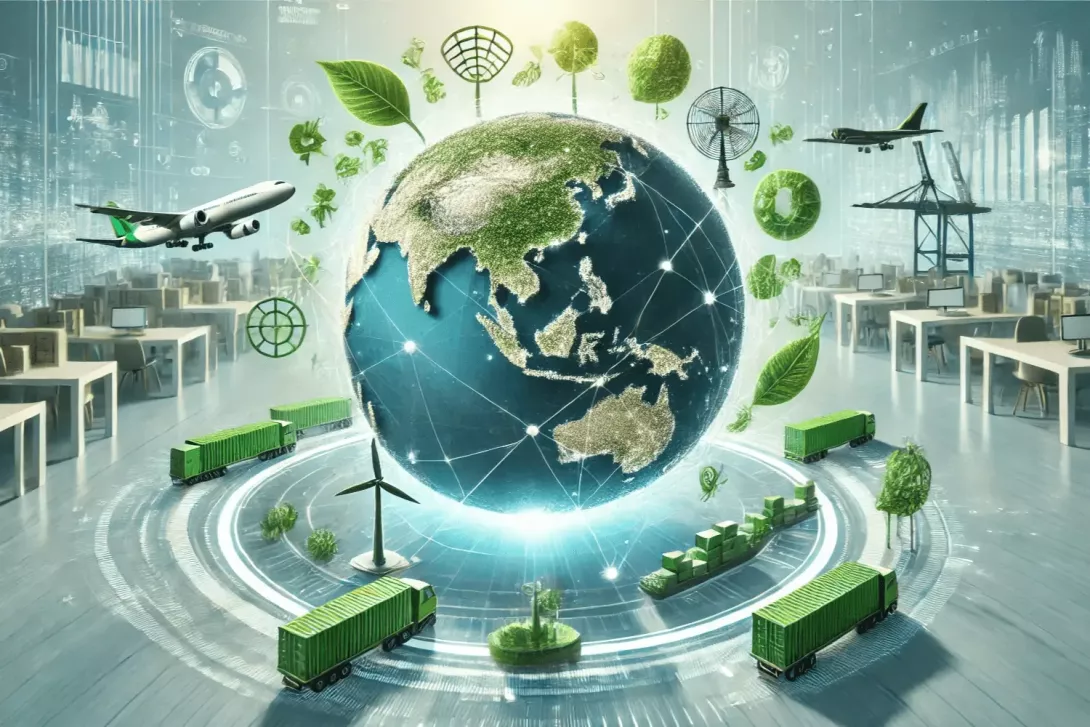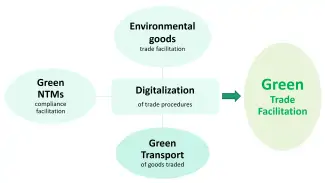
Photo credit: ChatGPT/Yern Fai Lee
International trade has been a key driver of economic growth and development, but its environmental impacts cannot be ignored. As highlighted in a flagship ESCAP-UNCTAD-UNEP report, the carbon emissions associated with trade – including from international freight transport and logistics – are significant. At the same time, trade has immense potential to facilitate access to green technologies, create markets for sustainable products, and incentivize cleaner production. The question is, how can we harness the benefits of trade while minimizing its environmental costs?
The answer may lie in an emerging concept: green trade facilitation. In collaboration with the Asian Development Bank (ADB), ESCAP organized a workshop with leading partners to explore opportunities in this area. Building on these findings, a conceptual framework has been developed, envisioning the greening of trade processes and supply chains across four key pillars – presented for the first time at the 11th Asia-Pacific Trade Facilitation Forum.

Green Trade Facilitation Diagram
Digitalizing trade procedures
At the core of this framework is the digitalization of trade procedures, which makes processes simpler and more transparent, thus reducing the associated use of resources and pollution. Research by ESCAP suggests that moving fully to paperless trade could save the Asia-Pacific region 13 million tons of CO2 annually – equivalent to planting 400 million trees. Beyond emissions savings, there would also be significant reductions in water use and waste generation, as each transaction now requires much less resources to process. The bulk of the benefits relate to the efficiency gains from process improvements that the use of digital documents, data and signatures enable – including less manpower and logistics facilities, as information is more easily shared among stakeholders, reducing unnecessary delays and storage needs.
Besides digitalizing trade procedures in general, the digitalization of documents under trade and environment-related conventions can be prioritized as part of green trade facilitation. For example, countries may wish to digitalize permits under the Convention on International Trade in Endangered Species (CITES). Another example would be to digitalize the documentation processes under the Basel Convention on the Control of Transboundary Movements of Hazardous Wastes. Trade in waste can enable better and more specialized waste treatment to reduce pollution and facilitate recycling, and hence can be an important part of the circular economy.
Facilitating trade in environmental goods
Green trade facilitation includes measures to ease trade in environmental goods –goods which contribute to environmental protection and climate goals, such as solar panels and energy saving or water treatment technologies, and goods important to the circular economy, such as second-hand products and recycled materials. A key challenge is the need to define and classify environmental goods, which are currently not specified in the Harmonized System (HS) codes. Countries can consider adopting an official definition or list of environmental goods, as well as implement procedures to expedite and streamline their clearance by customs and other relevant agencies, particularly through electronic means.
Greening the transport of traded goods
With international freight transport accounting for a substantial portion of trade-related greenhouse gas emissions, green trade facilitation extends to transport facilitation. This could involve measures such as incentivizing low-carbon shipping and aviation fuels, optimizing transport routes and consolidating shipments, as well as shifting to lower-emission modes like rail where possible. Much potential also lies in the digitalization of transport documents such as multimodal electronic cargo documentation, and the incorporation of transit transport facilitation in existing or new electronic border systems.
Facilitating compliance with environmental non-tariff measures
Green trade facilitation also encompasses measures to support compliance with environmental or sustainability-related regulatory procedures and requirements that are increasingly adopted by countries around the world. Emerging policies such as the European Union’s Carbon Border Adjustment Mechanism (CBAM) and Deforestation Regulation (EUDR) will require exporters to navigate complex new rules and prove their environmental credentials. Green trade facilitation can help by ensuring that requirements are transparent, streamlined, and integrated with accessible digital systems.
Measures could include establishing online information portals that provide clear and up-to-date information on environmental regulations and procedures, or developing standardized templates and guidance documents to help traders meet reporting and verification requirements. Capacity building programmes could also be provided to help small and medium-sized enterprises understand and comply with environmental standards in export markets. By reducing the compliance burden, green trade facilitation can help to level the playing field and ensure that environmental regulations do not become unintended barriers to trade.
Realizing the promise of green trade facilitation
The four pillars of green trade facilitation are interrelated and complementary to each other. In particular, digitalization is key to implementing measures in all areas. As such, implementation of the framework may be facilitated through the UN treaty on paperless trade (CPTA).
Promisingly, ESCAP and ADB are not alone in pushing this agenda forward. UNCTAD has supported countries in establishing Trade Information Portals that have dramatically cut paperwork and processing times. The Green Customs Initiative, a partnership among UNEP and other international organizations, focuses on enhancing capacity to facilitate legal trade in environmentally sensitive commodities. As a core partner of this initiative, the World Customs Organization has put forth a Green Customs Action Plan to assist customs administrations in reducing their environmental footprint and facilitating green trade.
The framework can be further expanded with detailed guidelines and actionable policy tools. Through concerted efforts across governments, international organizations, and the private sector, green trade facilitation can be utilized to secure more prosperous and greener trade for all.


